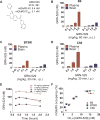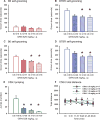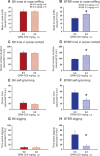Negative allosteric modulation of the mGluR5 receptor reduces repetitive behaviors and rescues social deficits in mouse models of autism
- PMID: 22539775
- PMCID: PMC4904784
- DOI: 10.1126/scitranslmed.3003501
Negative allosteric modulation of the mGluR5 receptor reduces repetitive behaviors and rescues social deficits in mouse models of autism
Abstract
Neurodevelopmental disorders such as autism and fragile X syndrome were long thought to be medically untreatable, on the assumption that brain dysfunctions were immutably hardwired before diagnosis. Recent revelations that many cases of autism are caused by mutations in genes that control the ongoing formation and maturation of synapses have challenged this dogma. Antagonists of metabotropic glutamate receptor subtype 5 (mGluR5), which modulate excitatory neurotransmission, are in clinical trials for fragile X syndrome, a major genetic cause of intellectual disabilities. About 30% of patients with fragile X syndrome meet the diagnostic criteria for autism. Reasoning by analogy, we considered the mGluR5 receptor as a potential target for intervention in autism. We used BTBR T+tf/J (BTBR) mice, an established model with robust behavioral phenotypes relevant to the three diagnostic behavioral symptoms of autism--unusual social interactions, impaired communication, and repetitive behaviors--to probe the efficacy of a selective negative allosteric modulator of the mGluR5 receptor, GRN-529. GRN-529 reduced repetitive behaviors in three cohorts of BTBR mice at doses that did not induce sedation in control assays of open field locomotion. In addition, the same nonsedating doses reduced the spontaneous stereotyped jumping that characterizes a second inbred strain of mice, C58/J. Further, GRN-529 partially reversed the striking lack of sociability in BTBR mice on some parameters of social approach and reciprocal social interactions. These findings raise the possibility that a single targeted pharmacological intervention may alleviate multiple diagnostic behavioral symptoms of autism.
Conflict of interest statement
Figures





Comment in
-
Tweaking the social network.Sci Transl Med. 2012 Apr 25;4(131):131fs9. doi: 10.1126/scitranslmed.3004017. Sci Transl Med. 2012. PMID: 22539770
-
Neurodevelopmental disorders: Glutamate blockers show benefit in models of autism spectrum disorders.Nat Rev Drug Discov. 2012 Jun 1;11(6):440-1. doi: 10.1038/nrd3761. Nat Rev Drug Discov. 2012. PMID: 22653211 No abstract available.
References
-
- Kogan MD, Blumberg SJ, Schieve LA, Boyle CA, Perrin JM, Ghandour RM, Singh GK, Strickland BB, Trevathan E, van Dyck PC. Prevalence of parent-reported diagnosis of autism spectrum disorder among children in the US, 2007. Pediatrics. 2009;124:1395–1403. - PubMed
-
- Lord C. Epidemiology: How common is autism? Nature. 2011;474:166–168. - PubMed
-
- American Psychiatric Association. Diagnostic Criteria from DSM-IV. American Psychiatric Association; Washington, DC: 1994.
Publication types
MeSH terms
Substances
Grants and funding
LinkOut - more resources
Full Text Sources
Other Literature Sources
Molecular Biology Databases
Miscellaneous

